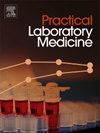甲状腺激素检测系统一致性评价:基于外部质量评价数据的比较研究
IF 1.7
Q3 MEDICAL LABORATORY TECHNOLOGY
引用次数: 0
摘要
目的利用外部质量评价(EQA)数据评价甲状腺激素检测的一致性,指导实验室质量提升和大数据互操作性。方法收集2022年1月至2024年12月患者T3、T4、FT3、FT4和TSH的seqa数据。我们使用偏倚和变异系数数据计算了我们实验室(TEa-Lab)和同行组(TEa-peer)的总允许误差。我们通过比较TEa值与三个生物变异阈值(最小值、理想值和最优值),推导出协调指数(HI)。HI值≤1表示协调满意。结果本实验室TSH检测结果一致性较好;然而,T3、T4、FT3和FT4的HI在1.1至1.9之间,未能达到最低协调水平。在同侪组测试中,各分析系统的协调程度各不相同,协调程度从低于最低协调程度到最佳协调程度不等,甚至没有达到最低协调程度。甲状腺激素的协调水平在我们的实验室和同龄人之间显示出很强的一致性。结论根据EQA数据定量计算的HI值准确反映了实验室甲状腺激素检测系统与同行群体的协调水平。这有助于识别实验室问题并实施纠正措施,为实验室大数据互操作性和临床决策提供参考。本文章由计算机程序翻译,如有差异,请以英文原文为准。
Evaluation of harmonization among thyroid hormone testing systems: A comparative study based on external quality assessment data
Objective
To evaluate thyroid hormone test harmonization using external quality assessment (EQA) data, guiding laboratory quality enhancement and big data interoperability.
Methods
EQA data for T3, T4, FT3, FT4, and TSH from January 2022 to December 2024 were collected. We calculated the total allowable error for both our laboratory (TEa-Lab) and peer groups (TEa-peer) using bias and coefficient of variation data. We derived harmonization indices (HI) by comparing TEa values against three biological variation thresholds (minimum, desirable, and optimal). An HI value ≤ 1 indicated satisfactory harmonization.
Results
The TSH test in our laboratory showed desirable harmonization; however, the HI for T3, T4, FT3, and FT4 ranged from 1.1 to 1.9, failing to reach the minimum harmonization level. Among the peer group tests, the level of coordination of each analysis system varies, and the harmonization levels ranging from below the minimum to the optimal harmonization level, even failing to reach the minimum level. The harmonization level of thyroid hormones between our laboratory and peer groups showed strong consistency.
Conclusion
The HI values quantitatively calculated from EQA data accurately reflect the harmonization level between thyroid hormone testing systems in the laboratory and peer groups. This helps identify laboratory issues and implement corrective actions, providing a reference for laboratory big data interoperability and clinical decision-making.
求助全文
通过发布文献求助,成功后即可免费获取论文全文。
去求助
来源期刊

Practical Laboratory Medicine
Health Professions-Radiological and Ultrasound Technology
CiteScore
3.50
自引率
0.00%
发文量
40
审稿时长
7 weeks
期刊介绍:
Practical Laboratory Medicine is a high-quality, peer-reviewed, international open-access journal publishing original research, new methods and critical evaluations, case reports and short papers in the fields of clinical chemistry and laboratory medicine. The objective of the journal is to provide practical information of immediate relevance to workers in clinical laboratories. The primary scope of the journal covers clinical chemistry, hematology, molecular biology and genetics relevant to laboratory medicine, microbiology, immunology, therapeutic drug monitoring and toxicology, laboratory management and informatics. We welcome papers which describe critical evaluations of biomarkers and their role in the diagnosis and treatment of clinically significant disease, validation of commercial and in-house IVD methods, method comparisons, interference reports, the development of new reagents and reference materials, reference range studies and regulatory compliance reports. Manuscripts describing the development of new methods applicable to laboratory medicine (including point-of-care testing) are particularly encouraged, even if preliminary or small scale.
 求助内容:
求助内容: 应助结果提醒方式:
应助结果提醒方式:


